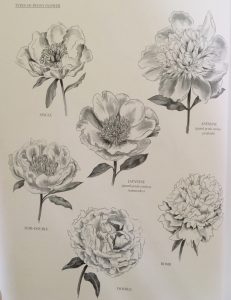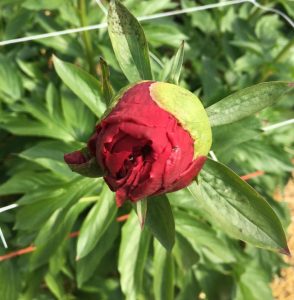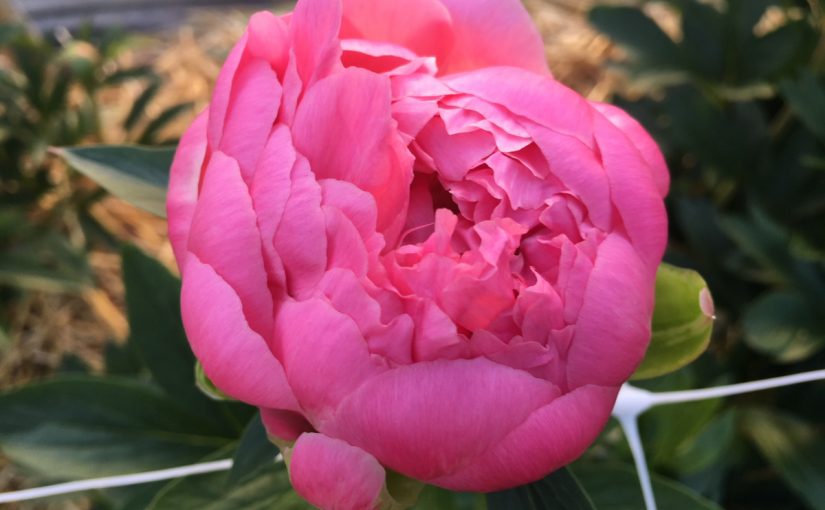Family: Paeoniaceae (all peonies and peony trees are members of this family). All members of this family are deciduous perennial herbs or shrubs, with thick roots for nutrient storage and thin roots for water/mineral collection.
Genus: Paeonia (only genus in the Paeoniaceae family; scientists debate the actual number of species, ranging from 25-40 species total. As of right now the official number is 33) (Eastoe).

Photo: page 7 from Jane Easton’s Peonies: Beautiful Varieties for Home and Garden
Paeonia species are native to Asia, Europe, and western North America. They are beloved garden favorite in temperate climates all around the world for their beautiful and fragrant spring blooms. They come in purple, pink, red, white, and yellow hues. Peony flower types are wide-ranging, related to where that specific variety evolved. These types include “single,” “Anemone” (guard petals enclose petaloids), “Japanese” (guard petals enclose staminodes), “Semi-Double,” “Double,” and “Bomb.” The botanical composition of a peony is based upon the flower type (see figures above and below) (Eastoe).
Peonies can be grown from zone 3-8, with zones 4-6 allowing basically any variety and type to survive and thrive. For zone 3, the hardier and later blooming varieties are ideal but often end up producing just fine. In fact there is a thriving peony farming trade in Alaska (see Alaska Peony Cooperative)! For zones 7-8, use earlier blooming varieties and be sure to research the chilling requirements for the specific cultivars you choose. Most peonies need some sort of cold period to trigger their flowering, so make sure your climate can provide that for them (Byczynski).

Photo: page 8 from Jane Easton’s Peonies: Beautiful Varieties for Home and Garden
According to The Old Farmer’s Almanac and Gardener’s Supply Company:
- Zone: 3-8
- Bloom Time: late spring to early summer
- Bloom Size: individual flowers are 6–10 mm long and 5–8 mm across, clustered in a dense terminate panicle 3-7 in (8-18 cm) long
- Height/Spread: .75-1.25ft (peony trees can be up to 11.5ft tall though)
- Soil: loamy well draining soil, neutral pH
- Site: partial to full sun (shadier site if in a hotter climate), pay special care to air flow as peonies are extremely susceptible to botrytis
- Type: Peony=herbaceous perennial, Tree peony=woody
- Seed Type: Dicotyledon
According to Doug Hock of Thistlehook Farms, peonies need to be dug up every 5-7 years (10 years is the absolute longest you can go without damage/death to the middle of the crown). The crowns can be teased apart if they split easily, or can be divided with a spade. Make sure to leave 3-4 eyes on each crown. Plant a foot apart in the fall. They will need some sort of netting or support to ensure the top-heavy blooms (especially the “double” and “bomb” varieties) don’t flop over. For the herbaceous perennial varieties, cut back any plant material at the end of the season to prevent the spread of botrytis.

Photo: Allie Kuppenbender
Put harvesting off for couple of years after planting to allow the peony to establish. Harvesting any flowers will impact rooting and the ability to store enough to overwinter. After those minimum three years, harvest peony flower buds at the “marshmallow” stage. Pinch the bud between two fingers to tell if it is as soft as a marshmallow. The bud will no longer be hard and there will be color exposed, but the bud will not be entirely open. This ensures a vase life of over one week. Can hold at this stage in a cooler for longer if need be.
SOURCES:
Peonies: Peony Bush, Peony Care, Growing Peonies, Gardener’s Supply Company
Peonies: Planting, Growing, and Caring for Peonies, The Old Farmer’s Almanac
Peonies: Beautiful Varieties for Home and Garden, Jane Eastoe
The Flower Farmer: An Organic Grower’s Guide to Raising and Selling Cut Flowers, Lynn Byczynski
